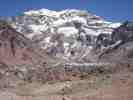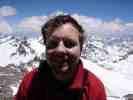|
Major High At the End Of 2005 For Local Mountaineer Local mountaineer Bob Kerr (27), from Melvich, has just returned to northern Scotland following a successful ascent of “Cerro Aconcagua” on 30th December 2005. Aconcagua is the highest mountain in South America and it is also the highest mountain in the world outside of Asia. This mountain is almost 23000’ high (6962m) and is located in the Andes mountain chain in western Argentina. To put the height of Aconcagua into perspective, Eastern Airways’ Jetstream 41 aircraft fly from Wick at a cruising height of about 21000’ and these aircraft are pressurised to provide adequate oxygen to its passengers.
Bob’s successful ascent of Aconcagua is the result
of nine months of careful planning and preparation. During his planning he
consulted colleagues from the Assynt Mountain Rescue Team who had
previously ascended Aconcagua. Mark Campball (from Lochinver), Chris
Warwick and Ken Keith (both from Achmelvich) summitted Aconcagua in
February 2004. He also consulted Brian Spence (one of the UKAEA Dounreay
shift managers) who had summitted Aconcagua over Christmas 2004. It is estimated that only about a third of the people who attempt Aconcagua succeed. The local weather conditions can hamper ascents (e.g. strong winds, lightning storms, extreme cold, heavy snow, etc) and nobody knows how they will perform at altitude until they are there (every time is different and good acclimatisation is essential). “Part of the excitement of mountaineering is the unknown and dealing with problems when they arise”. For example three days before Bob was due to fly out, his Madrid to Buenos Aires flight got cancelled by the airline company. Eventually he arrived in Mendoza, Argentina, on the morning of 20th December 2005 to meet up with a multinational team of climbers and a couple of local mountain guides. Due to flight cancellations, there was no time to acclimatise to the Mendozian heat of +30°C, instead the expedition permits were obtained and the team drove straight to the village of “Penitentes” in the Andean mountains (about 113 miles west of Mendoza). The climbing team began to get to know one another during this journey. The team consisted of two Scots, three English, one Canadian, one American, an Indian, a Brazilian and two local Argentines (9 climbers, 1 guide and 2 assistant guides). Before starting the trek in towards Aconcagua, the team paid a visit to “Cementerio de los Andinistas”. This very sobering visit kept the dangers of Aconcagua at the forefront of our minds for the rest of the trip. It should be stressed that not everyone buried in this cementry died on Aconcagua. One of the most prominent graves is that of Nicolás Plantamura, who made the first Argentine ascent of Aconcagua in 1934. The first day of trekking through the hot arid Andean mountains took the team up to Camp Confluencia (3390m). To assist with acclimatisation, the following day the team detoured from the “Northwest Route” to climb up to 4000m and get a view of the impressive south face of Aconcagua and the glacier coming from it. The tongue of the glacier coming from the south face has grown by 2000m in length over the last five years – it is not often that you see a glacier advancing so rapidly. The third day of trekking brought the team up to “Plaza de Mulas” which is affectionately known as “Base Camp” by many mountaineers. The base camp is located at 4350m above sea level. Bob said that “I was surprised with the facilities available at base camp. For example, you could use email via a satellite phone link or you could buy cervesa (beer) and coke from local companies.” Christmas Eve was a scheduled rest day to assist with acclimatisation. However, what this meant was that we spent Christmas Day carrying supplies of food, fuel, etc up to the next camp (“Camp Plaza Canada” at 5050m). It was a very strange Christmas experience. The only reminders that it was Christmas time were a few bits of tinsel on and in some of the tents. Boxing day was spent resting and continuing to acclimatise at Base Camp. On Boxing Day, two people from other groups were evacuated from the mountain by helicopter. One had developed severe frostbite during his summit attempt and another had come down with High Altitude Cerebal Edema (HACE). By this point we had heard of very few people successfully summitting Aconcagua due to the local weather conditions. This dampened our spirits a little. The next day we moved up to Camp Plaza Canada and spent the night there. The sunset over the Andes was spectacular. The 28th December saw us carrying all of our equipment and supplies to a higher camp (Camp Nido de Cóndores, 5560m). We were all beginning to feel the altitude and the associated cooler temperatures. On the 29th of December, we again carried large loads and set up camp at “Berlin Shelter” (5930m). I was now entering unknown territory in terms of my own experience at altitude. The highest that I had previously been was 5895m in January 2005 (summit of Kilimanjaro, highest mountain in Africa). We were now sleeping and living above the summit of Kilimanjaro. Our itinerary and supplies allowed us to stay at the Berlin Shelter for up to 4 nights if required. We were keen to minimize our time at altitude and go for the summit at the first appropriate weather window. On the morning of 30th December 2005, it was warm enough to venture out of our tents at 5:30am and go for the summit. The air temperature was only minus 27°C and there was a light fresh breeze blowing to make it feel even colder. I’ve never worn so many layers of clothing on a hill before and my extremities were still a bit cold. The problem with altitude is that you have to move slowly to get enough oxygen to your muscles but because you are moving slowly you are not generating much heat so you get cold very easily. As the sun came over the horizon, the air temperature began to rise slightly and we saw the impressive shadow of Aconcagua cast across the rest of the Andes. The team slowly gained height up the mountain and found the “Canaleta” section very tough going. It was basically walking up a very loose scree slope at altitude – 2 steps forward one step back. At 3:30pm, ten hours after leaving the tents, four of the climbing team and one of the assistant guides summitted Aconcagua (6962m, 22841’). The others had turned back at different stages with the guides due to various circumstances (e.g. too cold, dizziness, hypoxia, illness, etc). Those that summitted with Bob were Ashley Hale (from Norfolk, England), Michael Lies (from Kansas, USA), Jean Philippe Peppin (from Quebec, Canada) and the assistant guide known as “Bauty” (from Mendoza, Argentina). This was the tenth time that Bauty had been to the summit. The views from the summit were awesome but to survive Aconcagua means that you also need to get down safely. It is common for mountaineers to die in descent because they used all of their energy on the way up and they make silly mistakes on the way down. After four more hours of effort, all of the summit team had safely descended down to the “Berlin Shelter”. Here we had a cup of soup and crawled into our sleeping bags. We were all absolutely knackered and slept well at a height still above Kilimanjaro’s summit. The following day, Hogmany, we packed up camp and descended to “Base Camp”. During the descent it was evident to us that the weather was poorer and it had started to snow just after we reached base camp. We had been lucky. Our team brought in the New Year at 4350m – probably one of the highest partiers in the world that night. Enough alcohol was consumed to celebrate or commiserate our attempts on Aconcagua and to welcome in 2006! The team walked out from Aconcagua on New Year’s Day (with hangovers). As we were off the mountain a few days early we had the opportunity to sample the wines of the Mendoza region, watch tango dancers and do “normal” tourist activities in Argentina before returning home. All in all, Bob felt that it was a major high to finish 2005 with. |



